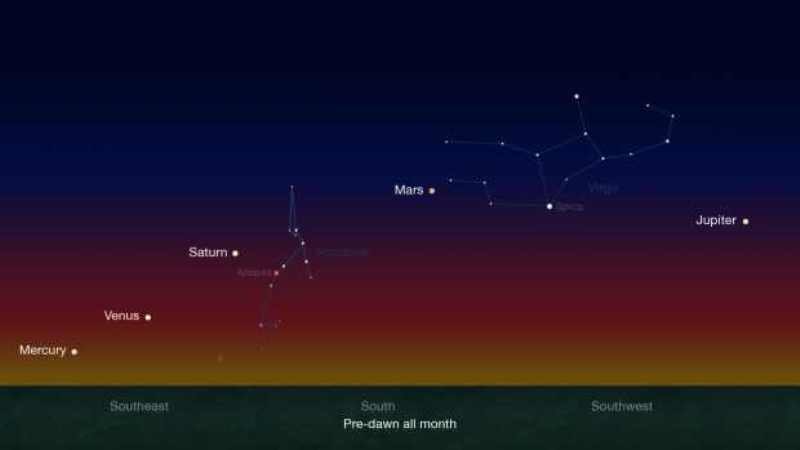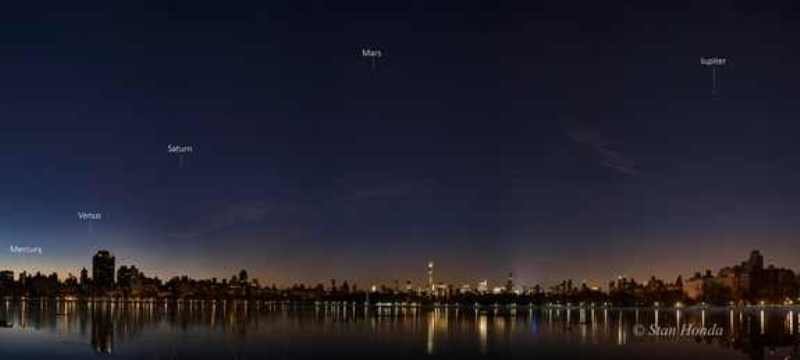
In early February, there will not be a single bright planet in the sky at dusk, but as the night progresses, dazzling Jupiter becomes more and more apparent, rising in the eastern sky during evening twilight. Next up is Mars, which doesn't arrive until the witching hour of midnight; its steady approach toward Earth causes it to increase noticeably in brightness. Jupiter is high toward the south when Mars emerges above the horizon, and Mars, in turn, is followed 2 to 3 hours later by Saturn. Then, within 2 hours of sunrise, Venus rises. It is followed closely by the innermost planet, Mercury, giving skywatchers an opportunity to see all five planets in the sky at once.
For most of us, the best opportunity to pull off this feat will come during the first week of February. [5 Dawn Planets And A Dusk Comet In Feb. 2016 Skywatching (Video)]
Remember, you can use your clenched fist at arm's length — equal to roughly 10 degrees of the night sky — to measure off angular distances. The brightest stars are equal to first or zero magnitude, while the very brightest objects (Venus, the moon and the sun) are of negative magnitude.
Here's a look at when to see the brightest planets in the February night sky (note that all skywatching is dependent on your local weather conditions):
Feb. 6 - A very thin (6-percent-illuminated) waning crescent moon forms a broad triangle with Venus and Mercury this morning, the moon hovering about 4 degrees above both planets. Mercury also reaches greatest elongation on this morning, 26 degrees west of the sun.
Venus appears brilliant above the southeast horizon, rising less than 2 hours before sunup at the start of the month. But by month's end, this planet — a small but dazzling dot as seen by telescope — sinks deep into the glow of dawn, rising only an hour before the sun. Meanwhile, Mercury is best seen early this month, when it rises in twilight in the south-southeast nearly 1.5 hours before sunup. Look for Mercury about 5 degrees to Venus' lower left during the first week of February, about 45 to 60 minutes before sunrise.

Thereafter, the view of Mercury degrades rapidly for observers in midnorthern latitudes as the planet closes in on the sun and moves southward across the ecliptic, which, at this time of year, lies low along the eastern morning horizon. Although still 20 degrees from the sun at month's end, Mercury will rise barely 40 minutes before sunrise, as seen at latitude 40 degrees north.Southern Hemisphere skywatchers, on the other hand, get an excellent view of it high in the dawn sky. [Best Night Sky Events of February 2016 (Stargazing Maps)]
Feb. 13 - Mercury and Venus engage in what is called a "quasi-conjunction." This is defined by Belgian astronomer Jean Meeus as "an approach of two bright planets within 5 degrees of each other, without a conjunction in right ascension." In other words, neither planet passes the other in the sky (to fulfill the strict definition of a conjunction), but they still approach each other rather closely. This morning, Venus comes to within 4 degrees to the upper right of Mercury.
Feb. 23 - Look toward the eastern sky early this evening, and you'll see the nearly full moon, accompanied by a brilliant silvery "star" a couple of degrees to its left. However, it's not a star, but rather the largest planet in our solar system, Jupiter. "Big Jupe" rises around 8:30 p.m. local time as February opens, and by the end of the month, it is coming up just minutes after the sun sets. On March 8, Jupiter will be at opposition — and hence will be the brightest and biggest in telescopes — but the giant planet is already impressive through the eyepiece. The most prominent dark belts of Jupiter are easy to see in even a fairly small telescope. Many other Jovian features can be glimpsed late on these nights with good optics. Jupiter is located in south-central Leo in February.
Feb. 29 - Mars is now rising shortly after midnight, and if you look toward the southeast around 1 or 2 a.m. on this leap day morning, you'll see it about 6 or 7 degrees below, and slightly to the left of, the waning gibbous moon. Fiery-hued Mars now rivals Procyon, the eighth-brightest star in the sky, and continues to brighten as it gets closer; the Red Planet is now 101 million miles (162.5 million kilometers) from Earth.



Comment: Five planets align for first time in a decade; last time: Indian Ocean earthquake and tsunami, December 26 2004